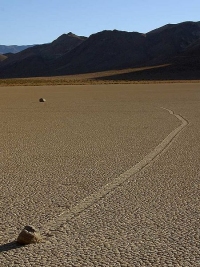
June Editorial
The sliding stones of Racetrack Playa

June Editorial
The sliding stones of Racetrack Playa
|
Nested in the Death Valley National Park of the western USA, with Cottonwood mountain to the east and the Last Chance Range to the west is Racetrack Playa - a seasonally dry lake which is home to an intriguing mystery. To understand the mystery it is first necessary to explain what a Playa is. During occasional heavy rains water washes down from the nearby mountains into the playa and for a short period the lake fills up. But the lake is always shallow, and in the strong sun of Death Valley, the water evaporates quickly leaving a layer of soft mud. As the mud dries, it shrinks and cracks into a mosaic of interlocking polygons. Racetrack playa, which is approximately 9 km square, is very flat and level; with the north end being only 4 cm higher than the south.
|
Racetrack Playa is a stark but beautiful area which has a unique feature - sliding stones. These are large rocks (some reaching 30-40 kg) from the 'grandstands' and other nearbyrock formations which break off and fall onto the lake. But the rocks don't just fall into the lake and stay there - without human or mechanical help they slide along the flat surface leaving a characteristic trail behind. The sailing rocks have made this remote playa world-famous. Most of the sliding rocks originate from a hillside made of dark dolomite on the south end of the playa, but some are intrusive igneous rock from adjacent slopes. These are tan-colored feldspar-rich syenite (syenite is a coarse-grained intrusive igneous rock of the same general composition as granite but with very little quartz.). | |
|
The sliding stones (also referred to as sailing rocks or moving rocks) are a geological phenomenon where rocks move in long tracks along a smooth valley floor without human or animal intervention. They have been first discovered around the 1900s. In 1948, geologists Jim McAllister and Allen Agnew mapped the bedrock of the area and described the tracks for the first time. That sparked many researchers to-date to try unravel the mystery of the movement of those rocks. In 1972 Bob Sharp and Dwight Carey started a Racetrack stone movement monitoring program. They labelled thirty stones with fresh tracks and their tracks were marked carefully. Each rock was even given its unique name. The movement of the rocks was carefully monitored over the next 7 years. There was no doubt about it. The rocks moved but the frustrating thing about their movement is that to date no-one has actually seen those rocks move. However, the absence of human and animal tracks around the rocks makes it perfectly clear that the rocks move by themselves. Physicists studying the phenomenon in 1995 found that winds blowing on playa surfaces can be compressed and intensified. Some gusts of wind, especially during winter storms, can reach up to 90 mph (145 km/h). These gusts are thought to be the initiating force while momentum and sustained winds keep the stones moving. There are two theories about the physics of moving the sliding stones:
Both theories are certainly credible and are not exclusive. Indeed the second theory builds upon the first. Racetrack stones only move every two or three years and most tracks develop over three to four years. Stones which are square with rough bottoms leave straight striated tracks, whereas smooth rocks wander. Stones sometimes turn over, exposing another edge to the ground and leaving a different track in the stone's wake. But is this phenomenon really unique to the Racetrack Playa? According to the National Park Service, there are 8 other playas near Death Valley where this phenomenon occurs. The mix of a clay-bottom lake bed, enough moisture to make it slick, rocks and strong winds occurs at these locations, too. | |
| _______________________________ | ||||
| Home | | | Shopping | | | Database |
© Biscuit Software 2004-2015
All rights reserved